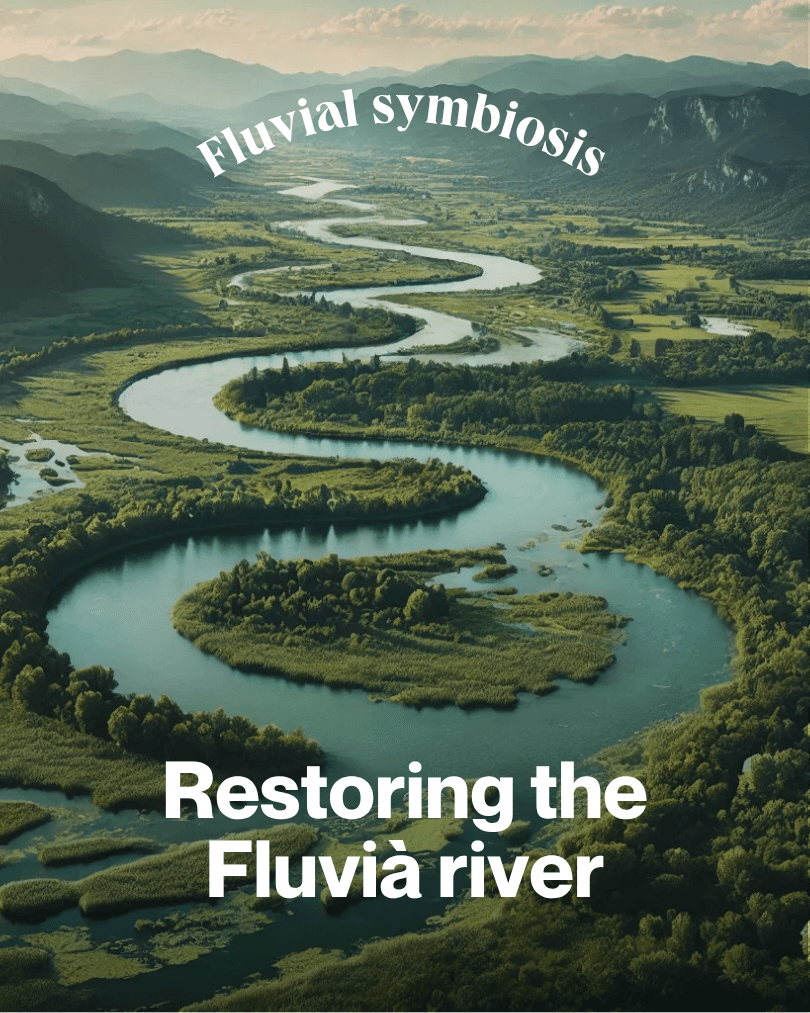Typology
Article
Scopes
Economy, Governance
When biodiversity decreases, what does the river teach us?
The river Fluvià, born in Collsacabra and crosses the Garrotxa to Sant Pere Pescador, is a fundamental element of the landscape and biodiversity of the region. Its ecological health is essential to the well-being of human communities and the conservation of natural ecosystems. This article discusses the current ecological state of the river Fluvià, the organizations involved in its conservation, ongoing bioregionalization initiatives and the importance of participatory governance in river management.
Ecological State of the River Fluvià
According to the Catalan Water Agency (ACA), the state of conservation of the river Fluvià presents significant challenges. At the head of the river, the ecological state is considered bad, while from Sant Joan les Fonts to the estuary in Sant Pere Pescador, it is classified as a mediocre. This degradation manifests in the decline of biodiversity, with a loss of 20% of biodiversity in Catalonia in recent years, especially in fluvial and aquatic environments, where loss reaches up to 60%.
Water
Factors contributing to this situation include decreased water flow, eutrophication and the presence of invasive species. For example, during periods of drought, the flow of the river can reduce more than two thirds in a month, causing water stagnation and loss of quality.
Call of the Generalitat de Catalunya
To address these challenges, the Department of Territory, Housing and Ecological Transition of the Generalitat de Catalunya has launched a call to fund projects to manage protected natural spaces that improve the state of conservation of natural heritage and biodiversity. One of the beneficiary projects is "Simbiosi Fluvial, regeneration and custody of the river Fluvià", led by Resilience Earth SCCL. This project aims to improve the state of conservation of the river by regeneration of two priority habitats: verneda and mixed deciduous forests with pendol oak.
The Nature Conservation Network (XCN), a network of environmental entities that promote conservation of nature through social involvement, land stewardship and environmental volunteering, plays a key role in coordinating and supporting projects such as this. The XCN facilitates collaboration between the public administrations, the entities of the third environmental sector and the local communities, ensuring integrated and participatory management of natural spaces.
Several entities are working together to improve the ecological state of the Fluvià river
Resilience Earth SCCL: Leads the project "Symbiosis Fluvial", with the aim of regenerating priority habitats and preserving endangered species such as white-legged crab, otter and hill.
Agrupació Naturalista de la GarrotxaIt participates in ecological restoration projects and monitoring the state of river ecosystems in the Garrotxa.
Silene AssociationEnvironmental organization founded by Josep Maria Mallarach, former director of the Garrotxa Volcanic Zone Natural Park, which works on the conservation of landscapes and ecosystems.
Habitats AssociationEnvironmental entity of the Empordà that promotes the conservation of rivers and streams in Catalonia, including the Fluvià.
Initiatives of Bioregionalization and Participatory Governance
The " Fluvial Symbiosis" project includes the creation of a Citizen Laboratory for a collaborative and sustainable river management, establishing an adaptive governance structure involving more than 40 municipalities and multilevel institutional relations. This initiative seeks to improve ecological connectivity between natural parks and wildlife reserves, involving the local community and the public and private sectors through a volunteer, education and communication plan.
The creation of a bioregional governance structure allows integrated management of the river Fluvià, taking into account the ecological, social and economic dynamics of the river basin. This approach facilitates informed decision-making and implementation of adaptive conservation measures, ensuring the sustainability of river ecosystems and the well-being of human communities.
By Relating the Site, we identify its layers and observe how these interact with each other, revealing evolutionary patterns that have led to the development of communities and ecosystems. This understanding is fundamental to address current challenges, as well as to imagine possible futures that are desirable and resilient.
Through a transdisciplinary approach, bioregionalization allows us to integrate multiple knowledge to generate local solutions, but also deeply aligned with global needs. Instead of working in isolation, it is proposed to create collaborative networks between communities, institutions, companies and other local entities. These interactions allow us not only to better understand social and ecological dynamics, but also to take advantage of the latent potential of the territory to face global challenges more efficiently and with long-term responses.
Working with the Inherent Potential of the Site
One of the central ideas in bioregionalization is the creation of solutions based on the inherent potential of the site. When we understand the Relate of the Site, we recognize what patterns make up the life of the territory, and this allows us to act consistently with local dynamics. Communities and territories are not static entities, but live and evolutionary systems. The Relate of the Site offers us the tools to identify possible futures based on these patterns and to generate adaptive strategies that prepare the territory for future changes, from global crises to internal transformations that may arise.
This latent potential hidden in the site is revealed when we look beyond external solutions and look for natural and social patterns that have allowed the survival and evolution of communities. The ability of a community to regenerate is closely related to the deep knowledge of the site, as this account allows us to identify the conditions, alliances and natural and social resources that have been built over time and have allowed balance within the ecosystem.
Crisis as Moments of Opportunity
A fundamental aspect of bioregionalization is the ability to see crises as moments for evolution. Crises should not only be seen as moments of fragility, but as stress points that, when understood correctly, can become catalysts for change. This is done through local collective intelligence, which is able to observe crises from multiple perspectives and generate deeper and holistic solutions. Bioregionalization teaches us to identify these stress points, whether economic, social or ecological, and to take advantage of them to transform them into regeneration opportunities.
Practices observed in contemporary bioregionalism show that, when performed locally with a deep understanding of territorial dynamics, global challenges such as climate change, loss of biodiversity or economic crises can be addressed in an adaptive and integrated way, opening the door to innovative and deeply rooted solutions on the site.
Adaptive and collaborative solutions design
Local co-creation processes are essential in this approach. Instead of imposing outside solutions, it works from the specific needs of the territory to create transversal and integrative strategies. Creating land labs, active collaboration spaces between various agents, creativity and innovation in the design of regenerative solutions is encouraged. This work not only allows changes to be adapted, but also takes advantage of social, economic and natural resources to build regenerative and adaptive solutions.
These co-creation spaces not only generate solutions for the immediate crisis, but also help communities visualize possible futures and prepare them so that solutions are enduring. This dynamic process of design and adaptation creates territories that are able to evolve over time and have the ability to regenerate through the natural and social dynamics that define them.

Conclusion
The bioregionalization of the Fluvià River exemplifies how collaboration between local entities, organizations and public administrations can transform river ecosystems, restore biodiversity and establish a sustainable management model that will inspire other initiatives at the regional and national level.
The bioregionalization of the river Fluvià is an essential initiative to restore and maintain the ecological health of this important water course. The collaboration between local entities, environmental organizations and public administrations, with the support of the Nature Conservation Network, is essential to ensure the regeneration of river habitats and to improve the conservation status of threatened species such as naiada, white-legged river crab, otter and hill. Through a participatory governance process, with the involvement of more than 40 municipalities and the creation of a Citizen Laboratory, a sustainable and integrated management of the river is sought.
One of the highlights of this project is that the river Fluvià is considered the river with the most potential to be completely renaturalized from Catalonia. This is not only a great opportunity to restore local river ecosystems, but will also serve as a model and benchmark for the management and renaturalization of other rivers in the country. With this project, we can recover a healthy and balanced relationship with our river courses, demonstrating that ecological restoration and collaborative management can be key to the conservation of natural heritage and biodiversity in Catalonia.
Crisis are not seen as fragilities, but as opportunities for transformation. The account of the site identifies points of tension and balance that allow to create deep and adaptive solutions. As proposed by the Regenesis Group, these solutions are proactive, aimed at regenerating the territory actively.
In addition, this process encourages cultural change in communities, creating a sense of belonging and shared responsibility. Communities become active agents of regeneration, preparing to face future changes with long-term strategies.
This application of bioregionalization increases territorial resilience, allowing the territory to regenerate through its own dynamics. The more we understand the interrelationships of the site, the more capacity we have to face global and local challenges, creating long-term solutions and helping communities to thrive.
In short, bioregionalization is a process of identifying active patterns and regeneration, which allows us to take advantage of the inherent potential of sites. This not only helps to face immediate challenges, but also opens the way to a more adaptive and resilient future. Crisis become opportunities for evolution and prosperity.

